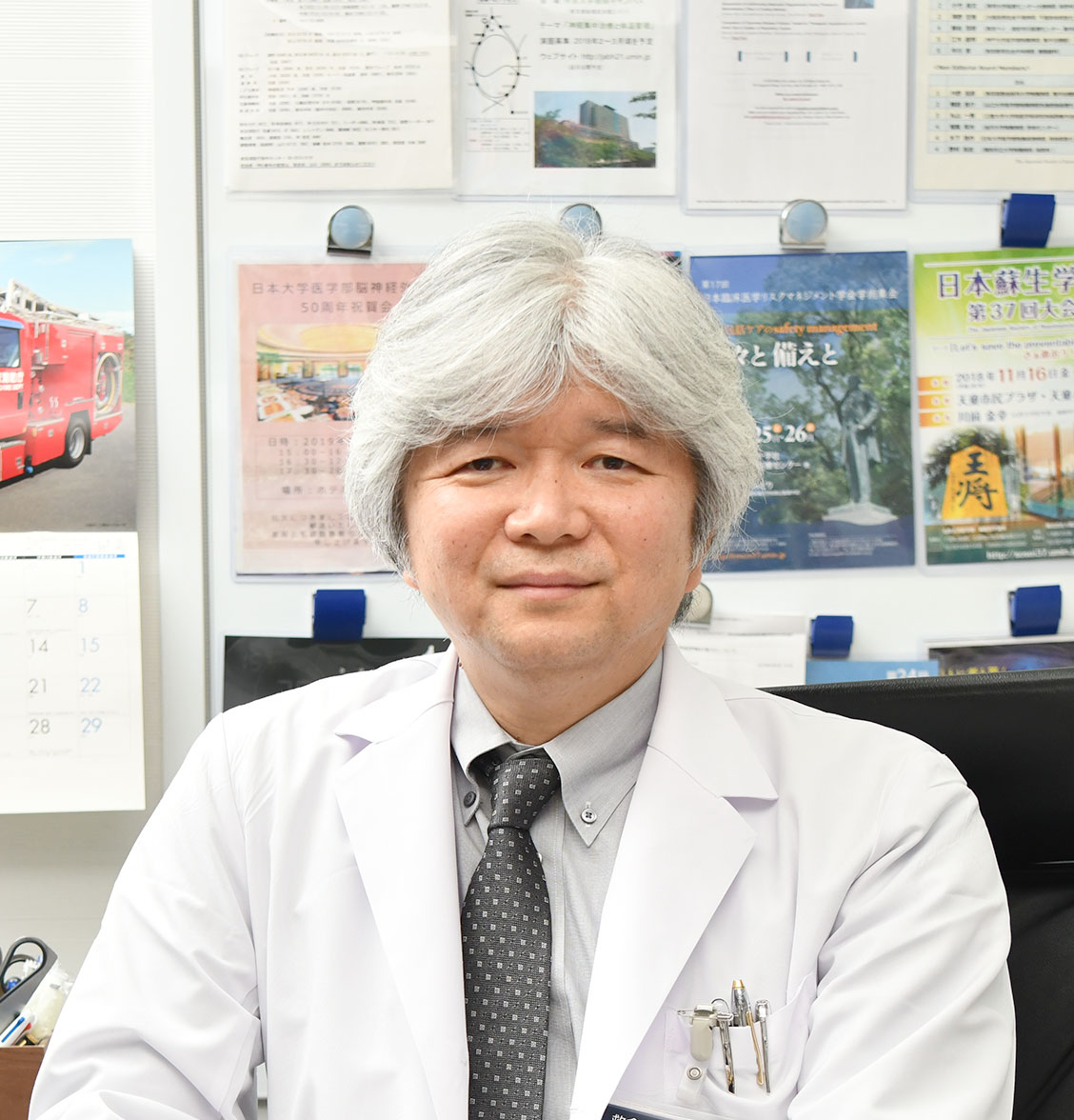ENGLISH
- TOP
- ENGLISH
Division of Emergency and Critical Care Medicine,
Department of Acute Medicine,
Nihon University School of Medicine

Kosaku Kinoshita, M.D., PhD. Chair and professor, Division of Emergency and Critical Care Medicine, Department of Acute Medicine, Nihon University School of Medicine
30-1 Oyaguchi Kamimachi Itabashi-ku, Tokyo
173-8610, Japan
TEL: +81-3-3972-8111
Ext: 2828, 8361
FAX: +81-3-5964-8037
E-mail: kinoshita.kosaku@nihon-u.ac.jp
Distinct characteristics of
our program and critical care unit
As our national population ages, we are seeing a yearly increase in the number of people requiring emergency medical care. Conversely, the number of child deaths due to accidents in Japan is high even among advanced nations, exposing the urgent need to build regional wide-area emergency care systems. In addition to being designated (by the Ministry of Health, Labour and Welfare) as an advanced treatment hospital in a secondary medical area serving 1.8 million residents, Nihon University Itabashi Hospital also serves as a Base Hospital for Disasters, a Pediatric Emergency and Critical Care Center, a Maternal Emergency and Critical Care and General Perinatal Emergency Medical Care Center, a Priority Hospital for Emergency Aortic Disease, and is a participating facility in the CCU Network and the Tokyo Burn Unit Association. Annually, over 2,200 seriously and critically sick and wounded patients are transported to our Critical Care Unit who require a wide variety of treatment including surgery for, among other symptoms, external injuries, burns, acute abdomen, acute coronary syndrome, poisoning, cardiopulmonary arrest, and other internal medical diseases. We are especially focusing on radical medicine that applies acute care for external injuries, acute care and cerebral protection therapy for central nervous system diseases, catheter therapy for acute coronary syndrome, intensive care for severe sepsis, and extracorporeal circulation and cerebral hypothermia therapy for cardiopulmonary arrest.
We conduct research on emergency and intensive care for pre-hospital and initial therapy and in the field of intensive care medicine. For the latter field, our research even covers: pathophysiological analysis and control of severe stress that occurs in severely traumatized or septic patients; comprehensive search for biomarkers associated with clinical outcomes of sepsis, cerebral infarction, and post cardiac arrest syndrome; establishing a nutrition therapy for critically ill patients; early brain function assessment method for post cardiac arrest syndrome patients; development of non-invasive cerebral protection devices (pulmonary cooling devices); and neurological intensive care and neurological monitoring.
Achievement
- Mukoyama T, Kinoshita K, Nagao K, Tanjoh K.: Reduced effectiveness of vasopressin in repeated doses for patients undergoing prolonged cardiopulmonary resuscitation. Resuscitation. 80(7):755-761, 2009
- Kinoshita K, Moriya T, Utagawa A, Sakurai A, Mukoyama T, Furukawa M, Yamaguchi J, Tanjoh K. Change in Brain Glucose After Enteral Nutrition in Subarachnoid Hemorrhage. J Surg Res. 162(2):221-224, 2010
- Tanjoh K, Moriya T, Kinoshita K. The peculiar processing of pancreatic hormone glucagon seen in traumatized patients. Hepatogastroenterology. 57 (99-100):620-4, 2010
- Nagao T, Kinoshita K, Sakurai A, Yamaguchi J, Furukawa M, Utagawa A, Moriya T, Azuhata T, Tanjoh K. Effects of bag-mask versus advanced airway ventilation for patients undergoing prolonged cardiopulmonary resuscitation in pre-hospital setting. J Emerg Med. 42 (2): 162-170, 2012.
- Sakurai A, Kinoshita K, Furukawa M, Noda A, Yamaguchi J, Kogawa R, Tanjoh K. Implication for Long-Term Hypothermia on Degradation of Interleukin-8 mRNA in Endothelial Cells Stimulated with Lipopolysaccharides. Ther Hypothermia Temp Manag. 2:67-72, 2012.
- Komatsu T, Kinoshita K, Sakurai A, Moriya T, Yamaguchi J, Sugita A, Kogawa R, Tanjoh K. Shorter time until return of spontaneous circulation is the only independent factor for a good neurological outcome in patients with postcardiac arrest syndrome. Emerg Med J. 2013 May 2. [Epub ahead of print]
- Kinoshita K, Sakurai K, Yamaguchi J, Furukawa M, Tanjoh K. Delayed augmentation effect of cytokine production after hyperthermia stimuli. Molecular Biology 48: 371-376, 2014.
- Kinoshita K. Possibility of predicting neurological outcome using regional cerebral oxygen saturation (rSO2) after cardiac arrest. Resuscitation. 85(9):e133, 2014
- Azuhata T, Kinoshita K, Kawano D, Komatsu T, Sakurai A, Chiba Y, Tanjho K. Time from admission to initiation of surgery for source control is a critical determinant of survival in patients with gastrointestinal perforation with associated septic shock. Crit Care. 2; 18(3):R87, 2014.
- Kogawa R, Kinoshita K, Tanjoh K. Increase in urinary sodium excretion in spinal cord injury patients in the emergency department. Eur J Trauma Emerg Surg. Mar 5, 2015
- Kinoshita K, Azuhata T, Kawano D, Kawahara Y. Relationships between pre-hospital characteristics and outcome in victims of foreign body airway obstruction during meals. Resuscitation. 88:63-67, 2015
- Kinoshita K, Sakurai A, Ihara S. The pitfalls of bedside regional cerebral oxygen saturation in the early stage of post cardiac arrest. Scand J Trauma Resusc Emerg Med. Nov 11; 23(1):95. 2015.
- Kinoshita K, Noda A, Sakurai A, Takahashi K, Nakajima M, Tanaka T: Reducing effect of cytokines with 5-aminolevulinic acid. Bull Exp Biol
- Sakurai A, Kinoshita K, Komatsu T, Yamaguchi J, Sugita A, Ihara S. Comparison of Outcomes Between Patients Treated by Therapeutic Hypothermia for Cardiac Arrest Due to Cardiac or Respiratory Causes. Ther Hypothermia Temp Manag. May 26, 2016
- Hori. S, Kinoshita K. Clinical characteristics of patients who overdose on multiple psychotropic drugs in Tokyo. JOURNAL OF TOXICOLOGICAL SCIENCES. 41(6) 765-773, 2016
- Kinoshita K. Transient Heterotopic Calcification and Unexpected Hypercalcemia after Treatment of Septic Shock.Internal Medicine. 55(9) 1207-1211, 2016
- Yamaguchi J, Kinoshita K. The Clinical Significance of Low Serum Arachidonic Acid in Sepsis Patients with Hypoalbuminemia, Internal Medicine, 57: 1833-18401, 2018
- Yamaguchi J, Kinoshita K. Delayed increase in serum acetaminophen concentration after ingestion of a combination medications: a case report, Journal of International Medical Research. 46(8) 3435–34391, 2018
- Yamaguchi J, Kinoshita K. Thromboembolic complications following tissue plasminogen activator therapy in patients of acute ischemic stroke - Case report and possibility for detection of cardiac thrombi.Open Medicine. doi.org/10.1515/med-2018-0081, 2018
- Yamaguchi J, Kinoshita K. Pediatric acute paradoxical cerebral embolism with pulmonary embolism caused by extremely small patent foramen ovale, Open Medicine, doi.org/10.1515/med-2019-0002, 2019

